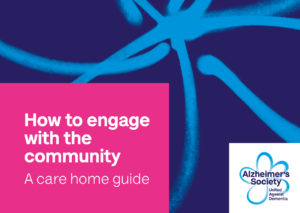The Alzeimer’s Society is exploring ways to reduce the isolation felt by many in care homes, through the Airedale Social Movement Programme.
The Alzheimer’s Society has been running the Airedale Social Movement Programme in Airedale, Wharfedale, Craven and Leeds since August 2016. This programme is funded by NHS England, as part of their New Models of Care; Health as a Social Movement Programme, until April 2018. The programme aims to bring local communities into care homes, and put care homes at the heart of their community.
Through our work on the programme we have set up lots of initiatives in care homes. Different community groups, including schools, bowling clubs and arts students have linked up with eight care homes and are regularly running activities with the care home residents to improve their quality of life, reduce their isolation and ensure they feel part of both the care home, and connected to the wider community.

Case study: Knit & Natter
To show the impacts of Alredale Social Movement I’d like to share a specific example of our work: Jean Booth lives at the Coach House care home. She loves to knit but had lost motivation to carry on knitting as she had no goal and no one to share it with. Our project started a Knit & Natter group within the home and has encouraged local volunteers to come in and join the group. The group decided that they wanted to start knitting blankets, hats and scarves for local charities to help vulnerable people.
Jean feels much more energetic and motivated and the knitting helps keep her hands flexible as she has quite advanced arthritis in both hands. She has commented on how she enjoys the social interaction, and feels more positive and useful now that she has a goal and is helping vulnerable families and refugees.
Jean reflects on the value of the experience for her as follows: “Julie (the project officer) has been wonderful. She really listened to me and arranged for someone to come and collect my blankets and send them on to help the Syrian refugees. I so look forward to the visits from Julie and Diane (the volunteers). They are so kind to me, and the knitting keeps me going”.
The Care Home staff have also noticed the difference in Jean, commenting that: “Jean is always talking about the visitors and can’t wait for them to call in again. She feels so proud of what she has achieved with them. She also likes teaching them more about knitting”
Overall it’s clear that Knit & Natter has really made a difference to Jean’s and other resident’s lives, and shows how regular social interaction and creative activities can have a huge positive impact on overall health and wellbeing.
Doing good = feeling good
Projects such as Knit & Natter are of benefit not only to the care home residents, but also to those supporting it through volunteering. Diane, one of the community volunteers, said: “I love coming to visit and have had great support from Julie (Project Officer). I feel pleased to see how happy Jean is and how proud she is of what she has produced. Julie really made her feel special, and always makes me feel appreciated too. Her recognition, thanking me for my generosity and kindness, makes all the difference”.
This shows that Knit & Natter is having a positive impact on volunteers as well as on the care home residents. Volunteers have a feeling of engagement and receive acknowledgement, therefore improving their own sense of wellbeing through the support they’re offering others.
Spreading our Learning
One of our objectives of the programme is to spread the programme so that others can replicate the work that has been undertaken locally, and we are currently working on resources to support this including a How To Guide for Care Home staff. This guide has just been launched and is available to download from www.alzheimers.org.uk/carehometoolkit
If you would like more information about this work, please contact Laura Cope (Programme Manager) at: laura.cope@alzheimers.org.uk.

